When it comes to water sports, the options are endless.
There are so many exciting activities to try, and one of them is prone paddle boarding.
From connecting to the water and getting a good workout in, the pros of this sport are unmatched!
Here we tell you all you need to know.
By the time you’re done reading this, you’ll be dying to give it a go!
What is Prone Paddle Boarding?
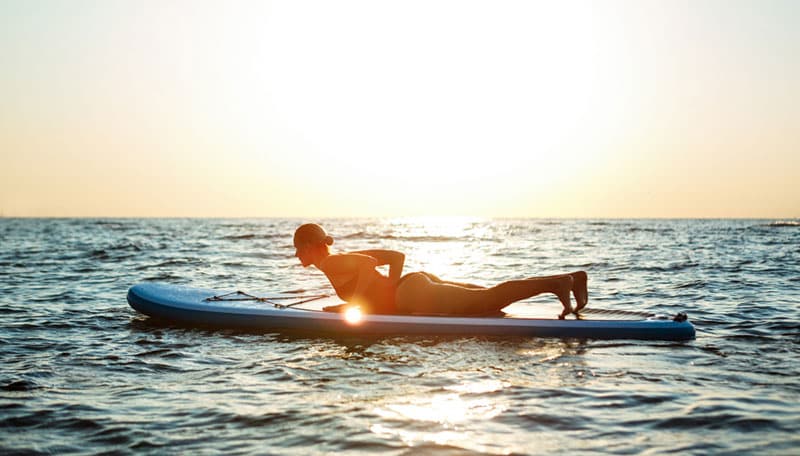
Prone paddle boarding is known as traditional paddle boarding, and it is a water sport.
You either kneel or lie down on a prone board, and you use your hands to paddle around.
It is basically like swimming but on a board!
All you really need to do is grab a paddle board and head to the water – simple as that (kind of).
It is one of the best ways to stay healthy and fit.
You will also be in constant contact with the water, which is beautiful, especially for those water babies out there!
Getting Started
Disclaimer: prone paddle boarding is not that easy, but don’t be discouraged, it takes some practice, and once you’ve got the hang of it, you’ll be wondering why you never tried it sooner.
Whenever getting into a new sport, it is always better to practice a bit.
And there are also a few things that you should focus on to do it properly and safely. Let’s take a look:
What you will need
Prone paddle boarding does not require a lot of equipment.
All you need is:
- a decent prone paddle board (obviously)
- your swimsuit
- a leash or strap
How to do it
Once you’ve got your gear, you’re ready to hit the water!
Take the board out into a shallow spot of water.
Hold the board on both sides where you can see the soft pads; they are near the front.
Now, climb onto the board and find a position that is comfortable and balanced.
If you are in a balanced position, no part of the board should be sticking out; it should be fully level on the water.
Lie on your stomach and move your arms in freestyle strokes to start paddling.
Stretch your arms as far as you can.
Don’t make very wide strokes, and paddle as close to the board as you can.
Kneel paddle boarding
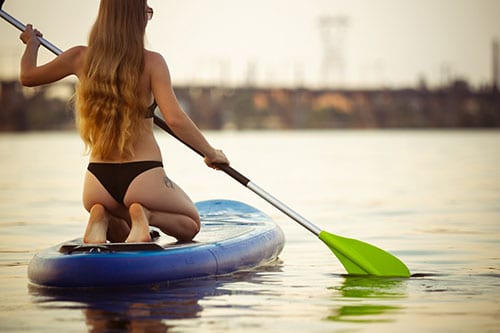
Now that you’ve got prone paddle boarding down to a T (sort of), you can try kneeling on your paddle board.
Just a heads up, this will be somewhat challenging – but you’ll get there with practice!
Again, hold your board on both sides, get on and find a balanced position.
Start by lying down and paddle a few times.
Then grab onto both sides of the board at about armpit level and use your arms for support.
Quickly rise up and pull your knees into the knee wells of the board.
Start moving your arms immediately to get paddling.
You will use both of your arms simultaneously to push the water back. And ta-da!
Types of Boards

When it comes to prone paddle boards, there are four types:
- There’s the 10’6″. This type of prone board is usually used for short races and coastal rescues. Since they are relatively short, they can make their way through almost any water, no matter the condition.
- The 12′. This prone board is well suited for long-distance paddle boarding. They are easy to manage on flat or bumpy waters, making them a good choice for long crossings. This type of board is not suitable for surfing.
- The 14 ‘. This board is also suitable for prone paddling long distances, but they are not as popular as the 12′ boards are.
- Unlimited prone boards or UL. These prone boards can be anything from 15-21 feet in length, they were made for long-distance paddle boarding, and most of these boards come fully equipped with a rudder system as an added bonus!
The Benefits
It’s loads of fun
It’s way more fun to lie down on the paddle board than it is to stand on it.
You can feel the board gliding through the water.
It is comfortable
After what I’ve told you, you may be wondering how on earth kneeling and straining your neck could be comfortable.
But once you’ve practiced a bit and gotten used to the board, the position will start to feel much more natural.
You also won’t get bored or tired as quickly, and you can change between positions to get more comfortable.
Less wind resistance
The best part about prone paddling is that the wind won’t bother you since you are so low down and won’t be as affected by the waves either.

It is simple
You really do not need much, just the board, your swimsuit, and a leash – and you are good to go.
Less gear also means less to carry and spending less money.
A great workout
Once you’ve started prone paddle boarding, you will see how much muscle strength and exercise it takes.
Eventually, you’ll start engaging more of your muscles, especially your core and arms.
The cons of prone paddleboarding
It is difficult
Starting will be challenging, and this tends to discourage some.
But everything takes time and a little practice.
Once you are through the beginning stages, it will be a breeze.
It is slow
It is not as fast as stand-up paddle boarding.
You will not stay dry
You will be coming out of that water sopping wet; you will likely get a lot of water in your face as well.
Prone Paddle Boarding vs. Stand Up Paddle Boarding
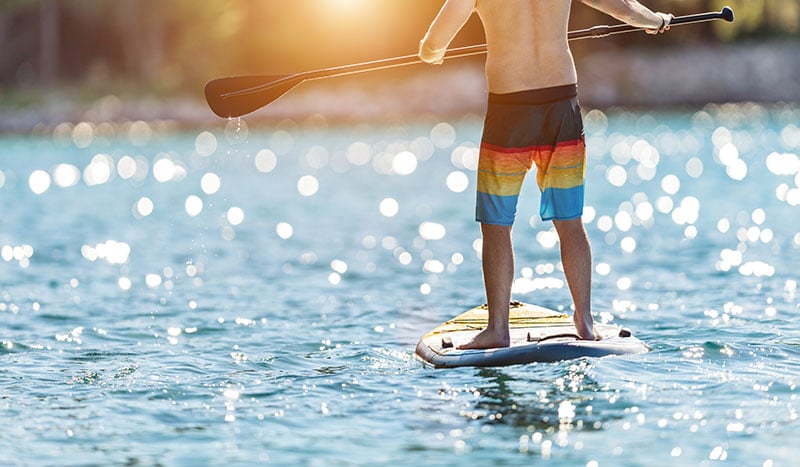
Even though stand-up paddle boarding originated from prone paddle boarding, there are a few differences between these two activities.
Paddlers use their arms when prone paddle boarding; they do so in a swimming movement.
While SUPing involves standing up on the board and using a single blade paddle to maneuver through the water.
In prone paddle boarding, you are either lying down or kneeling on the board, and in SUPing, one would stand.
Another difference between the two is the boards they use. The boards used for prone paddle boarding are extra-long.
They can be anything from 10-21 feet in length.
The boards also have a sharp-pointed tail and are incredibly narrow.
The top part may also be slightly sunken for some extra comfort.
And stand-up paddle boards are often a lot shorter and wider.
Our Top Tips

Look ahead
You are probably wondering how you’re supposed to see while lying down.
It will be slightly uncomfortable at first, but you will eventually find a position that works for you.
You can also get a foam chin rest to help out. But always look ahead of you!
Take water
If there is anything you take with you, let it be a water bottle – it will save your life!
You will likely be out there for hours, it gets very hot, and you will get thirsty.
Relax your neck
Avoid overextending your neck; just ensure that you keep it up and look ahead.
It is not impossible; prone paddlers have it down, so give it some time, and eventually, you’ll find a position that feels right and is comfortable for you.
Wear a leash
A leash can be very helpful, it is not vital, but it is great if you’re a beginner.
Either wear a leash on your ankle or a strap around your waist.
This way, you and the board will stay attached to each other at all times.
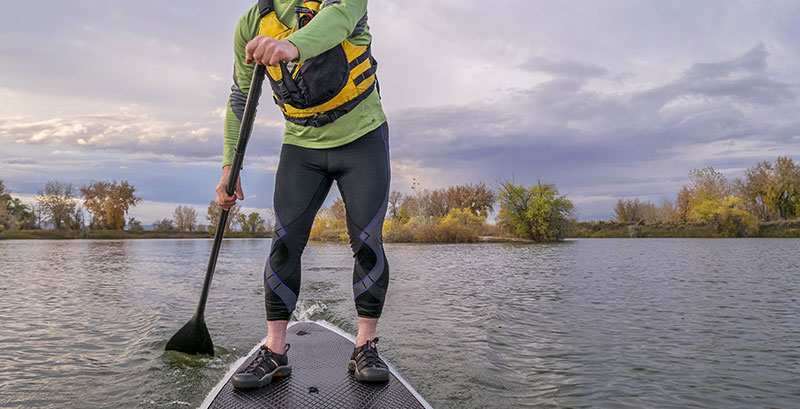
Wear comfortable clothes
When prone paddle boarding, you use your arms a lot, so avoid wearing anything that will limit your arm movement – sleeveless is best!
Colors are also important; it is better to wear something that makes you very visible.
You may also want to wear clothes that will cover your lower back to avoid sunburn.
Sunscreen is also your best friend; cover yourself up.
You don’t want to come out of the water in pain looking like a cherry tomato – trust me, it’s not fun!
Familiarize yourself with the board
There is no need to hurry; take some time to get to know your prone board.
Practice knee paddling and lying paddling. Give yourself some time to learn how to move around and maneuver the board.
Start in a shallow spot and then try in deeper water.
Momentum
Forward momentum is the way to go, it may seem scary at first, but it’s the best way and far less tiring.
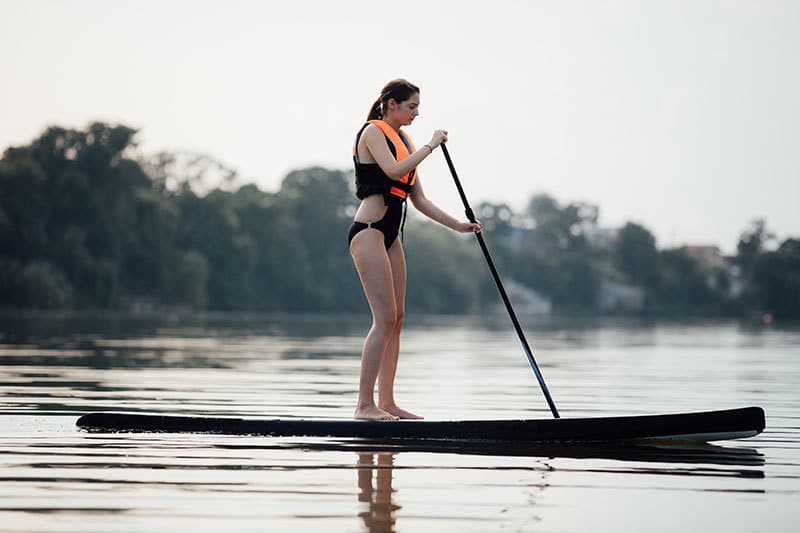
Stay vigilant
Remember that you are either lying or kneeling on a prone paddle board.
This means that you are not very visible.
So be aware of your surroundings and pay attention to other paddle boarders, jet skis, and boats.
Final Thoughts
At first, it won’t be easy, but you’ll be hooked once you’ve got the hang of it.
And now you know all you need to know in order to get started, so you have no excuse.
Grab a board and get on out there. It will be one of the best things you ever do!
